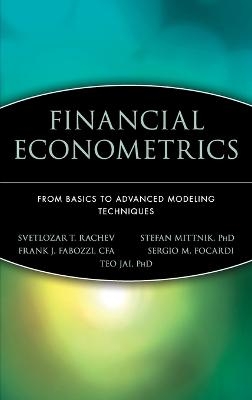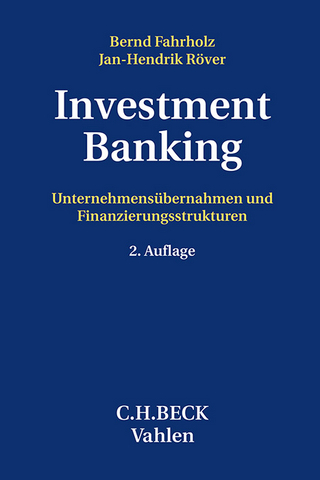
Financial Econometrics
John Wiley & Sons Inc (Verlag)
978-0-471-78450-0 (ISBN)
Svetlozar T. Rachev, PhD (Karlsruhe, Germany) is currently Chair-Professor at the University of Karlsruhe. Stefan Mittnik, PhD (Munich, Germany) is Professor of Financial Econometrics at the University of Munich. Frank J. Fabozzi, PhD, CFA, CFP (New Hope, PA) is an adjunct professor of Finance at Yale University’s School of Management. Sergio M. Focardi (Paris, France) is a founding partner of the Paris-based consulting firm The Intertek Group. Teo Jasic, PhD, (Frankfurt, Germany) is a senior manager with a leading international management consultancy firm in Frankfurt.
Svetlozar (Zari) T. Rachev completed his Ph.D. Degree in 1979 from Moscow State (Lomonosov) University, and his Doctor of Science Degree in 1986 from Steklov Mathematical Institute in Moscow. Currently he is Chair-Professor in Statistics, Econometrics and Mathematical Finance at the University of Karlsruhe in the School of Economics and Business Engineering. He is also Professor Emeritus at the University of California, Santa Barbara in the Department of Statistics and Applied Probability. He has published seven monographs, eight handbooks and special-edited volumes, and over 250 research articles. Professor Rachev is cofounder of Bravo Risk Management Group specializing in financial risk-management software. Bravo Group was recently acquired by FinAnalytica for which he currently serves as Chief-Scientist. Stefan Mittnik studied at the Technical University Berlin, Germany, the University of Sussex, England, and at Washington University in St. Louis, where he received his doctorate degree in economics. He is now Professor of Financial Econometrics at the University of Munich, Germany, and research director at the Ifo Institute for Economic Research in Munich. Prior to joining the University of Munich he taught at SUNYStony Brook, New York, the University of Kiel, Germany, and held several visiting positions, including that of Fulbright Distinguished Chair at Washington University in St. Louis. His research focuses on financial econometrics, risk management, and portfolio optimization. In addition to purely academic interests, Professor Mittnik directs the risk management program at the Center for Financial Studies in Frankfurt, Germany, and is co-founder of the Institut für Quantitative Finanzanalyse (IQF) in Kiel, where he now chairs the scientific advisory board. Frank J. Fabozzi is an Adjunct Professor of Finance and Becton Fellow in the School of Management at Yale University. Prior to joining the Yale faculty, he was a Visiting Professor of Finance in the Sloan School at MIT. Professor Fabozzi is a Fellow of the International Center for Finance at Yale University and on the Advisory Council for the Department of Operations Research and Financial Engineering at Princeton University. He is the editor of The Journal of Portfolio Management and an associate editor of the The Journal of Fixed Income. He earned a doctorate in economics from the City University of New York in 1972. In 2002 Professor Fabozzi was inducted into the Fixed Income Analysts Society’s Hall of Fame. He earned the designation of Chartered Financial Analyst and Certified Public Accountant. He has authored and edited numerous books in finance. Sergio Focardi is a partner of The Intertek Group and a member of the Editorial Board of the Journal of Portfolio Management. He is the (co-) author of numerous articles and books on financial modeling and risk management, including the CFA Institute’s recent monograph Trends in Quantitative Finance (co-authors Fabozzi and Kolm) and the award-winning books Financial Modeling of the Equity Market (co-authors Fabozzi and Kolm, Wiley) and The Mathematics of Financial Modeling and Investment Management (co-author Fabozzi, Wiley). Mr. Focardi has implemented long-short portfolio construction applications based on dynamic factor analysis and conducts research in the econometrics of large equity portfolios and the modeling of regime changes. He holds a degree in Electronic Engineering from the University of Genoa and a postgraduate degree in Communications from the Galileo Ferraris Electrotechnical Institute (Turin). Teo Jasic earned his doctorate (Dr.rer.pol.) in economics from the University of Karlsruhe in 2006. He also holds an MSc degree from the National University of Singapore and a Dipl.-Ing. degree from the University of Zagreb. Currently, he is a Postdoctoral Research Fellow at the Chair ofStatistics, Econometrics and Mathematical Finance at the University of Karlsruhe in the School of Economics and Business Engineering. He is also a senior manager in Financial & Risk Management Group of a leading international management consultancy firm in Frankfurt, Germany. His current professional and research interests are in the areas of asset management, risk management, and financial forecasting. Dr. Jasic has published more than a dozen research papers in internationally refereed journals.
Preface. Abbreviations and Acronyms.
About the Authors.
CHAPTER 1: Financial Econometrics: Scope and Methods.
The Data Generating Process.
Financial Econometrics at Work.
Time Horizon of Models.
Applications.
Appendix: Investment Management Process.
Concepts Explained in this Chapter (in order of presentation).
CHAPTER 2: Review of Probability and Statistics.
Concepts of Probability.
Principles of Estimation.
Bayesian Modeling.
Appendix A: Information Structures.
Appendix B: Filtration.
Concepts Explained in this Chapter (in order of presentation).
CHAPTER 3: Regression Analysis: Theory and Estimation.
The Concept of Dependence.
Regressions and Linear Models.
Estimation of Linear Regressions.
Sampling Distributions of Regressions.
Determining the Explanatory Power of a Regression.
Using Regression Analysis in Finance.
Stepwise Regression.
Nonnormality and Autocorrelation of the Residuals.
Pitfalls of Regressions.
Concepts Explained in this Chapter (in order of presentation) .
CHAPTER 4: Selected Topics in Regression Analysis.
Categorical and Dummy Variables in Regression Models.
Constrained Least Squares.
The Method of Moments and its Generalizations.
Concepts Explained in this Chapter (in order of presentation).
CHAPTER 5: Regression Applications in Finance.
Applications to the Investment Management Process.
A Test of Strong-Form Pricing Efficiency.
Tests of the CAPM.
Using the CAPM to Evaluate Manager Performance: The Jensen Measure.
Evidence for Multifactor Models.
Benchmark Selection: Sharpe Benchmarks.
Return-Based Style Analysis for Hedge Funds.
Hedge Fund Survival.
Bond Portfolio Applications.
Concepts Explained in this Chapter (in order of presentation).
CHAPTER 6: Modeling Univariate Time Series.
Difference Equations.
Terminology and Definitions.
Stationarity and Invertibility of ARMA Processes.
Linear Processes.
Identification Tools.
Concepts Explained in this Chapter (in order of presentation).
CHAPTER 7: Approaches to ARIMA Modeling and Forecasting.
Overview of Box-Jenkins Procedure.
Identification of Degree of Differencing.
Identification of Lag Orders.
Model Estimation.
Diagnostic Checking.
Forecasting.
Concepts Explained in this Chapter (in order of presentation).
CHAPTER 8: Autoregressive Conditional Heteroskedastic Models.
ARCH Process.
GARCH Process.
Estimation of the GARCH Models.
Stationary ARMA-GARCH Models.
Lagrange Multiplier Test.
Variants of the GARCH Model.
GARCH Model with Student’s t-Distributed Innovations.
Multivariate GARCH Formulations.
Appendix: Analysis of the Properties of the GARCH(1,1) Model.
Concepts Explained in this Chapter (in order of presentation).
CHAPTER 9: Vector Autoregressive Models I.
VAR Models Defined.
Stationary Autoregressive Distributed Lag Models.
Vector Autoregressive Moving Average Models.
Forecasting with VAR Models.
Appendix: Eigenvectors and Eigenvalues.
Concepts Explained in this Chapter (in order of presentation).
CHAPTER 10: Vector Autoregressive Models II.
Estimation of Stable VAR Models.
Estimating the Number of Lags.
Autocorrelation and Distributional Properties of Residuals.
VAR Illustration.
Concepts Explained in this Chapter (in order of presentation).
CHAPTER 11: Cointegration and State Space Models.
Cointegration.
Error Correction Models.
Theory and Methods of Estimation of Nonstationary VAR Models.
State-Space Models.
Concepts Explained in this Chapter (in order of presentation).
CHAPTER 12: Robust Estimation.
Robust Statistics.
Robust Estimators of Regressions.
Illustration: Robustness of the Corporate Bond Yield Spread Model.
Concepts Explained in this Chapter (in order of presentation).
CHAPTER 13: Principal Components Analysis and Factor Analysis.
Factor Models.
Principal Components Analysis.
Factor Analysis.
PCA and Factor Analysis Compared.
Concepts Explained in this Chapter (in order of presentation).
CHAPTER 14: Heavy-Tailed and Stable Distributions in Financial Econometrics.
Basic Facts and Definitions of Stable Distributions.
Properties of Stable Distributions.
Estimation of the Parameters of the Stable Distribution.
Applications to German Stock Data.
Appendix: Comparing Probability Distributions.
Concepts Explained in this Chapter (in order of presentation).
CHAPTER 15: ARMA and ARCH Models with Infinite-Variance Innovations.
Infinite Variance Autoregressive Processes.
Stable GARCH Models.
Estimation for the Stable GARCH Model.
Prediction of Conditional Densities.
Concepts Explained in this Chapter (in order of presentation).
APPENDIX: Monthly Returns for 20 Stocks: December 2000–November 2005.
INDEX.
| Erscheint lt. Verlag | 12.1.2007 |
|---|---|
| Reihe/Serie | Frank J. Fabozzi Series |
| Verlagsort | New York |
| Sprache | englisch |
| Maße | 161 x 231 mm |
| Gewicht | 774 g |
| Themenwelt | Wirtschaft ► Betriebswirtschaft / Management ► Finanzierung |
| Wirtschaft ► Volkswirtschaftslehre ► Ökonometrie | |
| ISBN-10 | 0-471-78450-8 / 0471784508 |
| ISBN-13 | 978-0-471-78450-0 / 9780471784500 |
| Zustand | Neuware |
| Haben Sie eine Frage zum Produkt? |
aus dem Bereich


